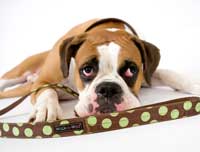Canine Separation Anxiety
by Kaye Davis of Moab BARKery
Separation anxiety is a common and serious problem for many dogs and their owners and is the 2nd most common reason dogs are relinquished or euthanized by their owners. Many owners confuse the symptoms of separation anxiety with gestures of doggie devotion, boredom or misbehavior, when in fact the dog is experiencing mental anguish, which is not healthy.
 If your dog suffers from true separation anxiety, they are having a panic attack similar to the ones that humans experience. This is a condition over which they have no control. Canine separation anxiety involves at least one and more often several of the following behaviors while you are away from home: If your dog suffers from true separation anxiety, they are having a panic attack similar to the ones that humans experience. This is a condition over which they have no control. Canine separation anxiety involves at least one and more often several of the following behaviors while you are away from home:
Non-stop whining, howling or barking, Physical signs of anxiety such as excessive panting, drooling and pacing, Relieving themselves indoors (even housetrained dogs), destruction of flooring, doors, windows, furniture and other items in the house; tearing up plants, shrubs and digging holes in the yard, Efforts to dig or paw their way out of their crate or another enclosed space, often resulting in self-injury.
Dogs are pack animals and are not used to being left alone or away from their pack. If most or all of the following statements are true about your dog, they may have a separation anxiety problem: The behavior primarily occurs when they are left alone and typically begins soon after you leave (in more severe cases it happens before you leave the house and they sense you are going to leave).
•They follow you from room to room whenever you’re home.
•They display frantic and effusive greeting behaviors.
•They react with excitement, depression or anxiety to your preparations to leave the house.
It is not fully understood why some dogs suffer from separation anxiety and others do not. What it is important to understand is your dog’s destructive, out-of-control behavior while they are in the midst of an episode isn’t deliberate or payback for being left alone – it’s coming from a very real terror they are feeling and that the behavior is a panic response and not disobedience.
 Some common scenarios that can trigger separation anxiety are, if you have a dog that is accustomed to constant human contact that is left alone for the first time or your dog experiences a traumatic event (from their perspective) such as time at a shelter or boarding kennel. Significant changes in a dog’s routine, like a move or the loss of a family member or other pet have also been known to cause separation anxiety. Some common scenarios that can trigger separation anxiety are, if you have a dog that is accustomed to constant human contact that is left alone for the first time or your dog experiences a traumatic event (from their perspective) such as time at a shelter or boarding kennel. Significant changes in a dog’s routine, like a move or the loss of a family member or other pet have also been known to cause separation anxiety.
If your dog suffers from a relatively mild form of the disorder, there are many ways to reduce their anxiety and increase their tolerance for being alone. Some of these things are simple to do; others will require effort and patience. Some methods work with certain dogs but not others, so be prepared to try different things.
Ignore your dog for a short period of time before you leave the house and upon your return. The idea is to make your comings and goings a non-event by taking no notice of their anxious behavior. Trying to soothe their anxiety with attention has the effect of rewarding the behavior and reinforcing the anxiety.
Desensitize your dog to all of the sights and sounds involved with your preparation to leave the house, in other words go through all of the motions to leave without leaving. Since you do not know exactly which cues your dog is reacting to, you will need to observe your dog carefully and make a mental (or written) note of your preparing-to-leave activities. These will include turning lights on or off, putting on shoes, jingling car keys, walking to the door, opening the door and so forth. Perform these tasks over and over, one at a time, without leaving the house, until your dog no longer takes much notice of the activity and you are able to leave the house for at least an hour and your dog is calm while you are gone. Leave your dog with an article of clothing with your scent on it. Leave a treat release toy like the Kong or Busy Buddy for your dog to focus their attention on or place small treats around the house for them to discover, along with their favorite toys.
Consider using a pheromone collar, pheromone spray or calming supplement such as Nutri-Vet Pet Ease. All of these products are designed to have a calming affect on dogs.
Make sure your dog gets plenty of exercise, playtime and mental stimulation. The fuller their life is when you are around, the calmer they will be when you are not.
If your dog exhibits a more severe case of separation anxiety it may take longer for them to be able to be calm when you are not around. Patience is required even more so with severe cases and whilst you should continue to use the techniques listed above, you may want to consider the following solutions in conjunction with those:
Ask your vet about drug therapy. A good anti-anxiety drug should reduce their overall anxiety not sedate them.
•Take your dog to a doggie daycare facility.
•Take your dog to work with you, if possible.
•Consult an animal behaviorist or professional for assistance in resolving your dog’s issues.
The most important thing to know as an owner of a dog that exhibits separation anxiety is what not to do. Understand that by choosing to do any of the following things that you are just contributing to making the situation a lot worse. What wont’ help is:
•Punishing your dog is not effective; the bad behaviors (house soiling, etc.) are a panic response and not a revengeful response to being left alone.
•Getting your dog a companion usually does not help. The anxiety is caused by separation from you, not just a result of being alone.
•Crating is usually not effective for anxious dogs and they may defecate, howl or even injure themselves in an attempt to escape. Instead create other kinds of safe places that confine loosely and have windows to provide distractions rather than total isolation.
•Leaving the radio or TV on will not help, they are missing you not the sound of any human voice.
•Obedience training will not help this particular issue. Separation anxiety is not the result of disobedience or lack of training.
With time, patience and experimentation with different methods for calming and desensitization, most dogs with separation anxiety can be relieved of the worst troubling symptoms. |